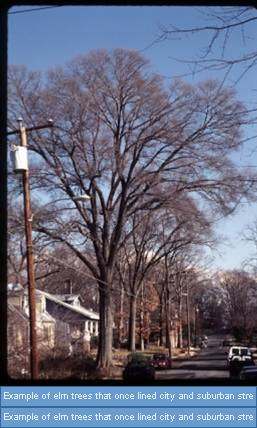
The elm zigzag sawfly (EZM; Aproceros leucopoda) was reported in the Western Hemisphere for the first time in Quebec in July 2020.
In 2021, only a year later, the sawfly was confirmed in northern Virginia [David Gianino, State Plant Regulatory Official (SPRO) of Virginia, pers. comm.]
There is 700 miles between Quebec and Virginia.
In September 2022, the sawfly was detected in St. Lawrence County, New York — just across the St. Lawrence River from Canada, where the insect has been known for two years. There is no information yet on impacts. [Brynda, S. “New pest affecting elm trees in St. Lawrence County.” October 3, 2022.
Impact in Europe
Elm zigzag sawfly is native to Eastern Asia — Japan and China for certain and, possibly Far Eastern Russia. There it is considered a minor pest. Serious localized defoliation, though, has been reported at least once, on the island of Hokkaido (Blank et al. 2021).
The sawfly was first detected outside its native range in Hungary and Poland in 2003. By 2010, the outbreak was revealed to be present over an area of 1,700 km, from eastern Ukraine to Austria. Other countries reporting the sawfly were Hungary, Poland, Romania, and Slovakia (Blank et al. 2010). Spread continued. By 2013 or 2014 elm zigzag sawfly was also reported in Belgium, Netherlands, and Germany — apparently the result of separate instances of human-assisted transport. German scientists calculated a natural spread rate of 45–90 km/yr. By 2018 the insect had reached the United Kingdom.
Severe localized defoliation by the species has been recorded on elms in a variety of situations across Europe. In some countries, defoliation has reached 74% or higher, even 100%. However, in other countries, such as Bulgaria, defoliation rates appear to be much lower (1-2%). Aproceros leucopoda showed no preference for host trees of a particular age. Heavily defoliated trees in Hungary did not seem to be dying (Blank et al. 2010).
The fear – in Europe and North America – is that elms already severely depleted by Dutch elm disease will be unable to sustain any decline in vigor caused by defoliation (Blank et al. 2010)
Probable Hosts
On the European continent, the sawfly has fed on several elms, including Ulmus minor, U. pumila and U. pumila var. arborea, U. glabra, and possibly. U. laevis (Blank et al. 2010). In the United Kingdom, it has fed on English elm (Ulmus procera), wych elm (U. glabra) and field elm (U. minor).
In Japan, collaborators in the Blank et al. (2010) study collected sawfly larvae on U. japonica and U. pumila.
In Virginia, larvae were collected from Chinese elm (U. parvifola). However, all species of elm trees native to North America are considered at risk. Also threatened are the native elm-browsing insects which might be out-competed by elm zigzag sawfly.
How the Sawfly Is Moved
Some have suggested that the EZS is transported on plants for planting, but they have not reported observations. Because elms are usually moved while dormant, it is more likely that the cryptic wintering cocoons are transported in leaf litter accompanying the trees rather than on the trees themselves.
Worrying Traits
The elm zigzag sawfly matures very rapidly. The total time from oviposition to emergence of mature individuals is 24–29 days (Blank et al. 2010). They can produce up to six or seven generations per year. The sawfly is also parthenogenic, so it can reproduce in the absence of males. As a result, populations can build up rapidly. No specific predators are known. The impact of generalist native parasitoids in Europe has not yet been studied.
Also, EZS tolerates a wide range of climates. Conditions on Hokkaido are similar to those in Central Europe. However, Hokkaido’s winters are usually colder, summers warmer, and annual precipitation higher. Blank et al. (2010) did not know limiting temperature and humidity but thought it probable that this species could spread into northern and south-western Europe wherever elms grow. In North America, the Canadian Food Inspection Agency expressed concern that EZS would be able to withstand temperatures as low as –30 °C which includes much of Canada.
While the elm zigzag sawfly was on the Alert List on the European and Mediterranean Plant Protection Organization (EPPO), in 2015 it was removed since no EPPO member country had requested international action (Blank et al. 2010).
SOURCES
Blank, S.M., H. Hara, J. Mikulas, G. Csoka, C. Ciornei, R. constantineanu, I. Constantineanu, L. Roller, E. Altemhofer, T. Huflejt, G. Vetek. 2010. Aproceros leucopoda (Hymenoptera: Argidae): An East Asian pest of elms (Ulmus spp.) invading Europe. European Journal of Entomology · March 2010
DOI: 10.14411/eje.2010.045
Blank, S.M., T. Köhler, T. Pfannenstill, N. Neuenfeldt, B. Zimmer, E. Jansen, A. Taeger, A.D. Liston. Zig-zagging across Central Europe: recent range extension, dispersal speed and larval hosts of Aproceros leucopoda (Hymenoptera, Argidae) in Germany. https://jhr.pensoft.net/articles.php?id=4395
Sinon, S. First confirmed sighting of a new invasive in North America: elm zigzag sawfly – Invasive Species Centre. https://www.invasivespeciescentre.ca/first-confirmed-sighting-of-a-new-invasive-in-north-america-elm-zigzag-sawfly/
(United Kingdom) Forest Research Elm zigzag sawfly (Aproceros leucopoda) https://www.forestresearch.gov.uk/tools-and-resources/fthr/pest-and-disease-resources/elm-zigzag-sawfly/
Posted by Faith Campbell
We welcome comments that supplement or correct factual information, suggest new approaches, or promote thoughtful consideration. We post comments that disagree with us — but not those we judge to be not civil or inflammatory.
For a detailed discussion of the policies and practices that have allowed these pests to enter and spread – and that do not promote effective restoration strategies – review the Fading Forests report at http://treeimprovement.utk.edu/FadingForests.htm
